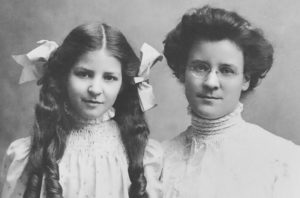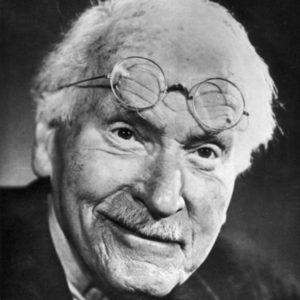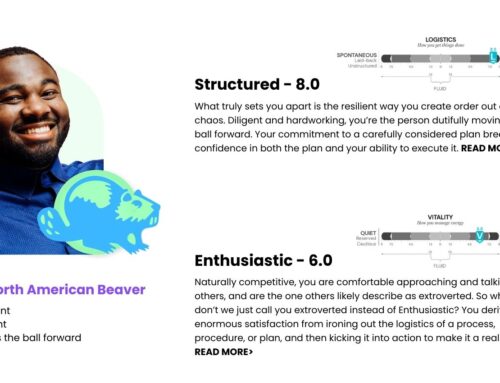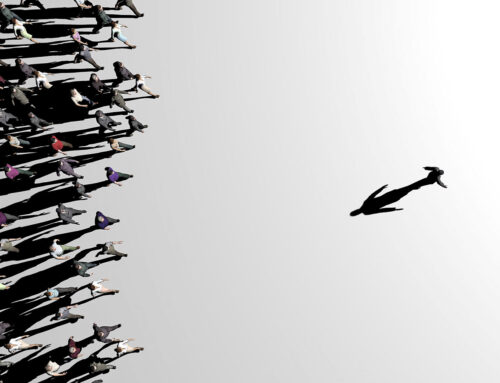Myers-Briggs: Memorable and Meaningless
Imagine hiring a guide to lead you across the wilderness only to discover he has no real experience in that stretch of the wilds. And while his advice keeps changing, he’s always very positive about it.
Might drive you a bit nuts, right?
Yet this is precisely what you get when you take the Myers-Briggs Type Indicator (MBTI) in hopes of better understanding your personality. Like our aforementioned guide, the MBTI’s creators knew nothing of personality science or any other form of science for that matter.
Which might explain why your four-letter result could change from one test to the next (hardly something to build self-awareness around). And the results are always served up in warm and cheerful language – hardly representative of the broad range of personalities familiar to us all.
Yes, the decades-old MBTI can be fun and memorable in the way a horoscope or Tarot card reading can be a lark shared with family and friends. But for those who genuinely want to apply the rigors of modern psychological science to understand their own personality, MBTI is pretty much worthless.
How worthless? The folks who run the MBTI have been forced to acknowledge the tool cannot be used for selecting people for jobs because it’s simply not a valid measurement of personality.
Or as the author of a book on Myers and Briggs put it: “Using the MBTI to unlock the mysteries of the self is akin to trying to understand the Stone Age by watching The Flintstones.”
Why the Popularity?
So why has Myers-Briggs persisted for so long? In part because of its use of the Barnum Effect, a well-known psychological phenomenon where people embrace overly broad, vague, and flattering descriptions of themselves (again, think of fortune cookies and horoscopes with their upbeat predictions about you). In other words, people are fans of fuzzy, flattering wordplay about themselves.
“Using the MBTI to unlock the mysteries of the self is akin to trying to understand the Stone Age by watching The Flintstones.”
It’s also because for so long there was no real competition. To the MBTI’s credit, it did introduce the idea of personality assessments to the masses. Unfortunately, it served up a false narrative that is still being debunked a century later.
And while today there are personality assessments and services steeped in the hard sciences, most are pricey, cumbersome, and so choked with jargon a professional intermediary is required to explain their results.

Isabel Briggs Myers and her mother, Katharine Cook Briggs
Regardless of why the discredited MBTI remains in use, the disturbing reality is that millions of people each year find themselves psychologically classified by the century-old invention of two women with zero back in the psychological sciences.
The Jungian Precedent
An avid fan of Carl Jung’s early efforts to understand and articulate cornerstone personality types, Katharine Cook Briggs made a study of the people around her, particularly her own daughter, Isabel Myers. Briggs would later explain that one of the principle reasons for her work was to improve parenting practices.
By the time Briggs was joined in her work by an adult Myers, they had moved beyond piggybacking on Jung’s work to adding their own criteria. Eventually, the Myers-Briggs duo settled on establishing personality by dividing people along four distinct axes:
- Introversion vs Extroversion
- Sensing vs Intuition
- Thinking vs Feeling
- Judging vs Perceiving
It was Myers who would successfully convince large government agencies, corporations, and universities to use the MBTI to more effectively assess their candidates.

The MBTI was built on Carl Jung’s early efforts to understand and type personality types.
Today, countless millions have taken the MBTI and continue to do so. Which is why, if someone announces him or herself as an INTJ or ESTP, we will likely recall the test even if not the meaning of the letters.
A Disturbing Allegiance
What makes the Myers-Briggs story so fascinating isn’t so much its amateurish origins. After all, the study of human psychology at the time was still very much in its infancy and Myers-Briggs were no different than many early tinkerers in other industries (think Wright Brothers or Jobs-Wozniak).
No, what makes it fascinating is that the MBTI, despite being largely discredited by anyone with a scientific pedigree, remains in practice across the globe not just as a pop psychology lark, but as an institutional means of categorizing and placing people for academic and professional purposes. (Which, if you do so and are sued, expect to lose.)
Indeed, today Myers-Briggs is the cornerstone to a multi-billion-dollar pop psychology industry focused on personality assessments, which persists in using unproven calculations to tell students what they should study, corporations what kinds of roles are best for employees, and government agencies (among other things) which people will make the best spies.
As science writer Joseph Stromberg writes, it would be one thing if people looked at the MBTI for pop entertainment the way they do social media quizzes. “But there is something wrong with CPP [the current owner of MBTI] peddling the test as ‘reliable and valid, backed by ongoing global research and development investment.'”
And perhaps because so many schools and companies continue to introduce new generations to the MBTI, the larger population also continues to take the test through various practitioners, mistakenly believing it will help them better understand themselves.
But as S. Alexander Haslam, a professor of psychology at the University of Queensland, writes: “Using the MBTI to unlock the mysteries of the self, is akin to trying to understand the Stone Age by watching The Flintstones.”
A Necessary Evil?
If Myers-Briggs has largely been discounted by the professional community, is there really any danger in organizations continuing to use it for assessments?
Well, consider for a moment that the MBTI indicates 80% of management types hail from just four of its 16 personality types. Meaning that the HR managers, guidance counselors, and other placement professionals trained in using MBTI are being told to funnel people fitting those other 12 types into non-leadership roles.
“The Myers-Briggs is useful for one thing: entertainment.”
“What concerns me is the cult-like devotion of many consultants and practitioners to [Mysers-Briggs] without the examination of the evidence,” says Adam Grant, a professor of industrial psychology at the University of Pennsylvania’s Wharton School.
He argues that despite psychologists themselves having no use for Myers-Briggs, their financial relationships with practitioners who do use it makes it something of a “necessary evil. I want to have an influence with practitioners, so I can’t poke a hole in their sacred cow.”
Furthermore, MBTI and other ‘type’ assessments don’t include emotions in their assessments, which of course is one of the single strongest indicators of how people will think and behave in a given moment.
Ultimately, most who are familiar with the tool’s many inadequacies dismiss it as little more than a tool for entertainment. “People like it because it reveals something they didn’t know about themselves or others,” says Grant. “That could be true of a horoscope too.”
Stromberg agrees: “The Myers-Briggs is useful for one thing: entertainment.”
Science has Joined the Race
Fortunately, actual empirically demonstrated, peer-reviewed behavioral sciences research has been elbowing its way into the institutional and cultural assessment arenas, most recently in the form of the Five-Factor Model (as we do here at InsightFull, but with a significant caveat – more on that in a moment).
Also known as the Big Five Personality Theory, the theory is based on a considerable body of research conducted over many years that defines personality in terms of five core traits: openness to experience, conscientiousness, extroversion, agreeableness, and neuroticism.
And as opposed to the MBTI, there is actual evidence demonstrating that the Big 5 provides legitimately predictive results that can assist people in charting a productive path for themselves based on their personality findings.
Myers-Briggs: Memorable and Meaningless
Imagine hiring a guide to lead you across the wilderness only to discover he has no real experience in that stretch of the wilds. And while his advice keeps changing, he’s always very positive about it.
Might drive you a bit nuts, right?
Yet this is precisely what you get when you take the Myers-Briggs Type Indicator (MBTI) in hopes of better understanding your personality. Like our aforementioned guide, the MBTI’s creators knew nothing of personality science or any other form of science for that matter.
Which might explain why your four-letter result could change from one test to the next (hardly something to build self-awareness around). And the results are always served up in warm and cheerful language – hardly representative of the broad range of personalities familiar to us all.
Yes, the decades-old MBTI can be fun and memorable in the way a horoscope or Tarot card reading can be a lark shared with family and friends. But for those who genuinely want to apply the rigors of modern psychological science to understand their own personality, MBTI is pretty much worthless.
How worthless? The folks who run the MBTI have been forced to acknowledge the tool cannot be used for selecting people for jobs because it’s simply not a valid measurement of personality.
Or as the author of a book on Myers and Briggs put it: “Using the MBTI to unlock the mysteries of the self is akin to trying to understand the Stone Age by watching The Flintstones.”
Why the Popularity?
So why has Myers-Briggs persisted for so long? In part because of its use of the Barnum Effect, a well-known psychological phenomenon where people embrace overly broad, vague, and flattering descriptions of themselves (again, think of fortune cookies and horoscopes with their upbeat predictions about you). In other words, people are fans of fuzzy, flattering wordplay about themselves.
“Using the MBTI to unlock the mysteries of the self is akin to trying to understand the Stone Age by watching The Flintstones.”
It’s also because for so long there was no real competition. To the MBTI’s credit, it did introduce the idea of personality assessments to the masses. Unfortunately, it served up a false narrative that is still being debunked a century later.
And while today there are personality assessments and services steeped in the hard sciences, most are pricey, cumbersome, and so choked with jargon a professional intermediary is required to explain their results.

Isabel Briggs Myers and her mother, Katharine Cook Briggs
Regardless of why the discredited MBTI remains in use, the disturbing reality is that millions of people each year find themselves psychologically classified by the century-old invention of two women with zero back in the psychological sciences.
The Jungian Precedent
An avid fan of Carl Jung’s early efforts to understand and articulate cornerstone personality types, Katharine Cook Briggs made a study of the people around her, particularly her own daughter, Isabel Myers. Briggs would later explain that one of the principle reasons for her work was to improve parenting practices.
By the time Briggs was joined in her work by an adult Myers, they had moved beyond piggybacking on Jung’s work to adding their own criteria. Eventually, the Myers-Briggs duo settled on establishing personality by dividing people along four distinct axes:
- Introversion vs Extroversion
- Sensing vs Intuition
- Thinking vs Feeling
- Judging vs Perceiving
It was Myers who would successfully convince large government agencies, corporations, and universities to use the MBTI to more effectively assess their candidates.

The MBTI was built on Carl Jung’s early efforts to understand and type personality types.
Today, countless millions have taken the MBTI and continue to do so. Which is why, if someone announces him or herself as an INTJ or ESTP, we will likely recall the test even if not the meaning of the letters.
A Disturbing Allegiance
What makes the Myers-Briggs story so fascinating isn’t so much its amateurish origins. After all, the study of human psychology at the time was still very much in its infancy and Myers-Briggs were no different than many early tinkerers in other industries (think Wright Brothers or Jobs-Wozniak).
No, what makes it fascinating is that the MBTI, despite being largely discredited by anyone with a scientific pedigree, remains in practice across the globe not just as a pop psychology lark, but as an institutional means of categorizing and placing people for academic and professional purposes. (Which, if you do so and are sued, expect to lose.)
Indeed, today Myers-Briggs is the cornerstone to a multi-billion-dollar pop psychology industry focused on personality assessments, which persists in using unproven calculations to tell students what they should study, corporations what kinds of roles are best for employees, and government agencies (among other things) which people will make the best spies.
As science writer Joseph Stromberg writes, it would be one thing if people looked at the MBTI for pop entertainment the way they do social media quizzes. “But there is something wrong with CPP [the current owner of MBTI] peddling the test as ‘reliable and valid, backed by ongoing global research and development investment.'”
And perhaps because so many schools and companies continue to introduce new generations to the MBTI, the larger population also continues to take the test through various practitioners, mistakenly believing it will help them better understand themselves.
But as S. Alexander Haslam, a professor of psychology at the University of Queensland, writes: “Using the MBTI to unlock the mysteries of the self, is akin to trying to understand the Stone Age by watching The Flintstones.”
A Necessary Evil?
If Myers-Briggs has largely been discounted by the professional community, is there really any danger in organizations continuing to use it for assessments?
Well, consider for a moment that the MBTI indicates 80% of management types hail from just four of its 16 personality types. Meaning that the HR managers, guidance counselors, and other placement professionals trained in using MBTI are being told to funnel people fitting those other 12 types into non-leadership roles.
“The Myers-Briggs is useful for one thing: entertainment.”
“What concerns me is the cult-like devotion of many consultants and practitioners to [Mysers-Briggs] without the examination of the evidence,” says Adam Grant, a professor of industrial psychology at the University of Pennsylvania’s Wharton School.
He argues that despite psychologists themselves having no use for Myers-Briggs, their financial relationships with practitioners who do use it makes it something of a “necessary evil. I want to have an influence with practitioners, so I can’t poke a hole in their sacred cow.”
Furthermore, MBTI and other ‘type’ assessments don’t include emotions in their assessments, which of course is one of the single strongest indicators of how people will think and behave in a given moment.
Ultimately, most who are familiar with the tool’s many inadequacies dismiss it as little more than a tool for entertainment. “People like it because it reveals something they didn’t know about themselves or others,” says Grant. “That could be true of a horoscope too.”
Stromberg agrees: “The Myers-Briggs is useful for one thing: entertainment.”
Science has Joined the Race
Fortunately, actual empirically demonstrated, peer-reviewed behavioral sciences research has been elbowing its way into the institutional and cultural assessment arenas, most recently in the form of the Five-Factor Model (as we do here at InsightFull, but with a significant caveat – more on that in a moment).
Also known as the Big Five Personality Theory, the theory is based on a considerable body of research conducted over many years that defines personality in terms of five core traits: openness to experience, conscientiousness, extroversion, agreeableness, and neuroticism.
And as opposed to the MBTI, there is actual evidence demonstrating that the Big 5 provides legitimately predictive results that can assist people in charting a productive path for themselves based on their personality findings.



